MXA RACE TEST: THE REAL TEST OF THE 2021 GASGAS MC 450F
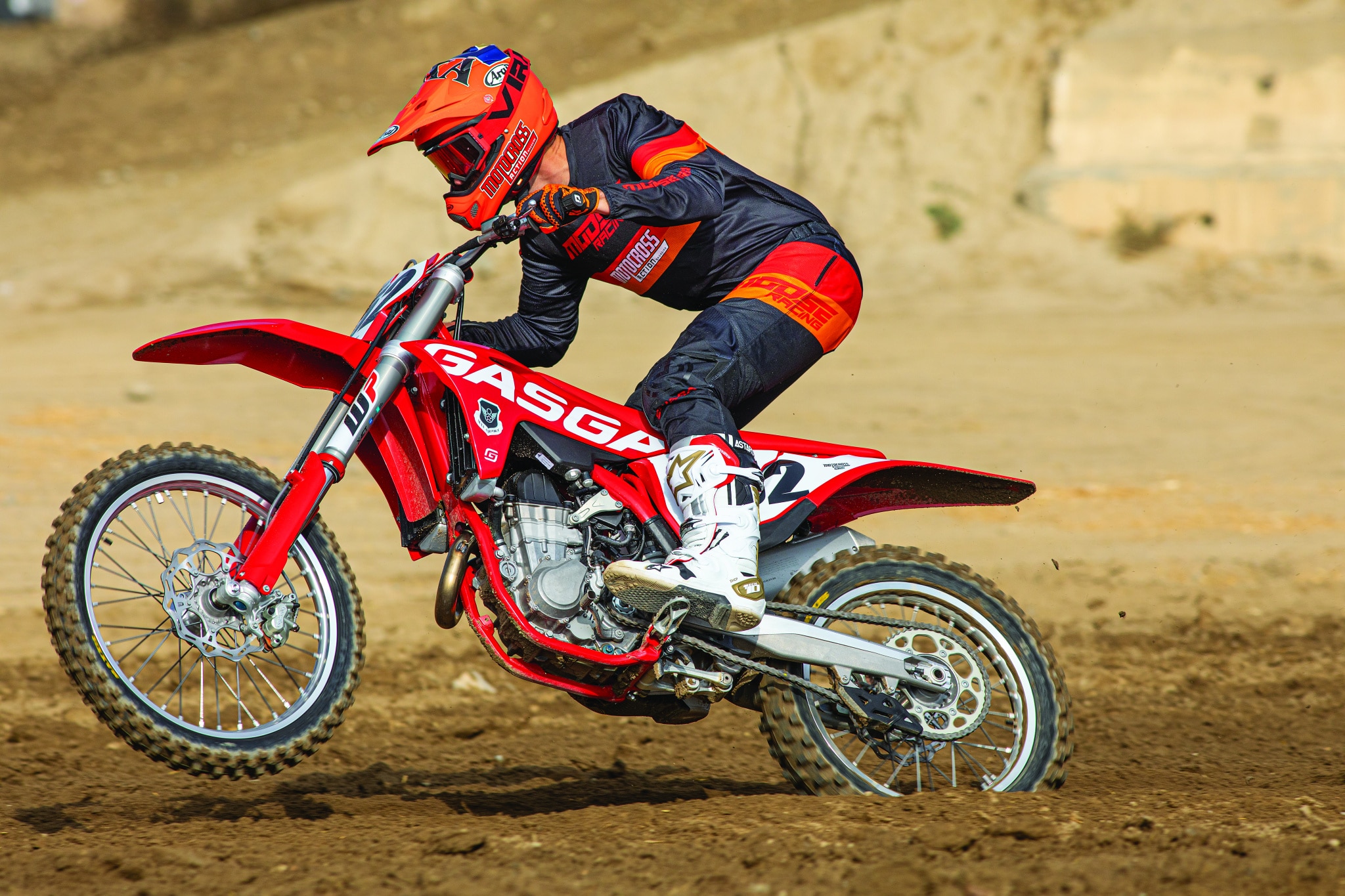
Q: FIRST AND FOREMOST, IS THE 2021 GASGAS MC 450F BETTER THAN THE 2020 MC 450F?
A: No, but that is only because this is the first generation of Austrian-built GasGas motocross bikes. Prior to 2021, GasGas was a Spanish brand that specialized in off-road bikes. That previous GasGas is now called Rieju, and the new GasGas is manufactured by KTM using platform sharing.
Q: WHAT IS “PLATFORM SHARING”?
A: Platform sharing is when a manufacturer uses major components from one brand as the basis for another. This can include engines, frames, suspension components, wheels and brakes. Platform sharing saves money because the manufacturer gets the benefits of economy of scale. Instead of having to build new frames and engines for each of their vehicles—and make separate and expensive production runs of each, the manufacturer can enjoy the benefits of sharing the same parts across several different models or brands.
The automotive industry is rife with platform sharing. General Motors has eight models among four brands that use the identical C1XX architecture and engines. Volkswagen has an astounding 48 models, including VW, Audi, Skoda, Seat, and Land Rover, that have utilized its MQB platform. The BMW FAAR platform is shared by Jaguar and Land Rover, along with some BMW engines—and, of course, the Toyota Supra and Subaru BRZ share the BMW Z4 chassis and engines.
In GasGas’ case, platform sharing allowed Pierer Mobility AG, the owner of GasGas, KTM, Husqvarna, Pankl, Kiska Design, Avocodo Softwear, Pexco electric bikes and WP, to have 12 Austrian-built 2021 GasGas models on the showroom floors within 14 months of purchasing a majority stake in GasGas from previous owner Black Toro Capital. Without platform sharing, there would not have been any new GasGas models until the 2022 model year—at the soonest.
Q: HOW DOES A 2021 GASGAS MC 450F DIFFER FROM THE 2021 KTM 450SXF?
A: It doesn’t, at least in any major mechanical parts. There are slight aesthetic differences in some of the running gear but nothing that doesn’t have the same basic KTM DNA strand. Here are the eight most obvious differences.
(1) Plastic. The all-red plastic is surprisingly the biggest-selling feature of the GasGas MC 450F. As with Ferraris, red has a magnetic pull on the pysche of performance enthusiasts. GasGas’ fenders, side panels, front number plate, airbox cover and gas tank are uniquely GasGas.
(2) Tires. GasGas comes with Jeremy McGrath-model Maxxis MaxxCross MX-ST tires instead of KTM’s and Husqvarna’s Dunlop MX33s. These are decent tires, and if they don’t work in your terrain, you can mount whatever you want when they wear out.
(3) Rims. Although they are unbranded, they are basically the same Takasago Excel rims as on the KTM 450SXF but without the black anodizing. MXA prefers silver rims, because black rims get beaten up by roost and tire irons and look weathered in a couple months. Not so with silver rims.
(4) Triple clamps. Instead of the CNC-machined, billet-aluminum triple clamps from the KTM or Husky, the GasGas MC 450F comes with forged aluminum triple clamps. If you consider this to be a downgrade, then you can say the same thing about Honda, Yamaha, Kawasaki and Suzuki triple clamps—all of which are forged. Don’t call them “cast triple clamps.” Forging is to casting what titanium is to mild steel. Please note that the torque specs on the GasGas triple clamps differ from the KTM torque specs. The top clamp is 20 N/mm, while the bottom clamp is 15 N/mm.
(5) Handlebars. The silver-coated handlebars are the exact same Neken bars as on the KTM 450SXF. Only the color has been changed. Plus, the GasGas comes with a downsized crossbar pad.
(6) Exhaust system. At first glance, you will notice that the GasGas MC 450F exhaust pipe does not come with the two-stroke-looking resonance chamber. Additionally, the GasGas muffler isn’t free-flowing. It has the dreaded ice-cream-cone-shaped restrictor in the perf core.
(7) Swingarm. The GasGas swingarm is different from the KTM 450SXF unit, but that’s because it has been borrowed from the Husqvarna FC450. The engineers insist that apart from cosmetic changes, all three swingarms—KTM, Husky and GasGas—have the same flex and rigidity characteristics.
(8) Hour meter. KTMs and Husqvarnas come with hour meters on the top triple clamp. The GasGas does not (because their isn’t room on the forged clamp, but GaGas does sell a bracket to hold an hour meter).
Componentry-wise, those are the only parts that aren’t shared with the KTM 450SXF; however, there are performance areas where there are major differences between KTM and GasGas. We will get to those soon.
Q: WHAT IS THE “BALANCE OF PERFORMANCE” THAT THE GASGAS ENGINEERS WERE SEEKING?
A: Honda, Suzuki, Kawasaki and Yamaha engineers only have to think about one level of performance for the CRF450, RM-Z450, KX450 and YZ450F, because they only make one 450 motocross bike per model year. Honda can focus on max horsepower, Suzuki on minimal cost, Kawasaki on usability and Yamaha on durability. Not so for the Pierer Mobility Group’s engineers. They are producing three 450 motocross bikes, each in competition with the Japanese “Big Four” and, strangely enough, with the bikes that are rolling down the same Mattighofen, Austria, assembly line. They want each bike to have its own unique traits that separate it from its Austrian brethren, but none of the three brands want to be the low man on the totem pole. To solve the hierarchical dilemma, the three in-house engineering groups are asked to focus on the needs of the demographic group that the marketing department thinks need to be best served.
KTM 450SXF: It’s no secret that if there were a totem pole, KTM would sit on the top of it. The 450SXF is designed as a premium race bike, built without limits for serious motocross racers. Sort of the Ford GT40 of dirt bikes.
Husqvarna FC450: Husqvarna, based on its traditional history, makes R&D decisions that identify it as the perfect Vet bike brand. The engineers will deny that they are building Husqvarna FC450s to suit well-to-do gentleman racers who are looking for ease of use, a broader powerband, plush suspension, a low seat height and a taste of luxury. More like James Bond’s Aston Martin DB5 than a Le Mans prototype.
GasGas MC 450F: The GasGas is John Milner’s 1932 Ford hot rod from the movie American Graffiti, although few of the Austrian engineers know anything about American hot-rod car culture, let alone a 1973 movie set in Modesto, California, in 1962. In essence, the 2021 GasGas is a sleeper. It is a stripped-down, economy version of the KTM 450SXF. It doesn’t have everything that the 2021 KTM 450SXF has, but, as with a treasure hunt, under the glossy red paint job is a true-to-life KTM 450SXF engine. The GasGas doesn’t have its sights set on competing with its higher-on-the-totem-pole brothers. It is built to steal customers from the “Big Four,” with a price that matches them dollar for dollar.
GasGas’ Balance of Performance allows them to strip some high-end features from the KTM 450SXF without damaging the performance of the GasGas MC 450F in comparison to what the Big Four offer.
Q: HOW GOOD IS THE GASGAS MC 450F SUSPENSION?
A: You might think that the GasGas marketeers would cheap out on the MC 450F suspension, but they didn’t. The fork and shock on the 2021 GasGas MC 450F are the same components as on the KTM and Husky units (although they are not shortened like the Husky forks and shock; we wish they were, because we love that Husky stuff). The GasGas XACT air forks got 2021’s new oil-bypass notches, air seal, trampoline valve, larger negative chamber, rubber bump stop, extended crossover slot and easy-to-use rebound clicker. What they didn’t get is the Pro-level KTM 450SXF valving or the Vet-friendly plushness of the Husqvarna’s 10mm-shorter XACT forks.
If you think that we are insinuating that the GasGas XACT forks aren’t as good as the KTM or Husqvarna versions, we aren’t. They are valved and configured for a different demographic from their brothers. They are set up softer with a much more pleasant feel through chatter bumps, rolling whoops and big jumps. The compression and rebound damping are lighter than the KTM 450SXF setup, but they are stiff enough at full stroke to resist bottoming. If you are a Pro, you will find them too soft, but if you’re a real Pro, you will have your own personal suspension tuner on speed dial and wouldn’t be caught dead on stock forks. These forks aren’t for really, really fast guys. They are for regular folk—and for the vast majority of motocross racers, they work exceptionally well.
The GasGas shock reminds us of the 2019 Husqvarna shock, right down to GasGas’ 42 N/mm shock spring (the 2021 KTM and Husky run 45 N/mm springs). The shock feels very fluid. We didn’t vary far from the stock settings; however, if you are over 185 pounds or fast, you will probably want the 45 N/mm spring.
One note of caution: If you roll your GasGas MC 450 straight from the showroom to the track, the forks and shock are going to feel horrid. They are set up at the WP factory with tight tolerances, which means they require a break-in period to allow the seals, bushings and shims to begin to flow. The MXA test riders hated the GasGas suspension for the first couple hours, but then they came around to the point where we could reset the clickers and air pressure back to the stock positions.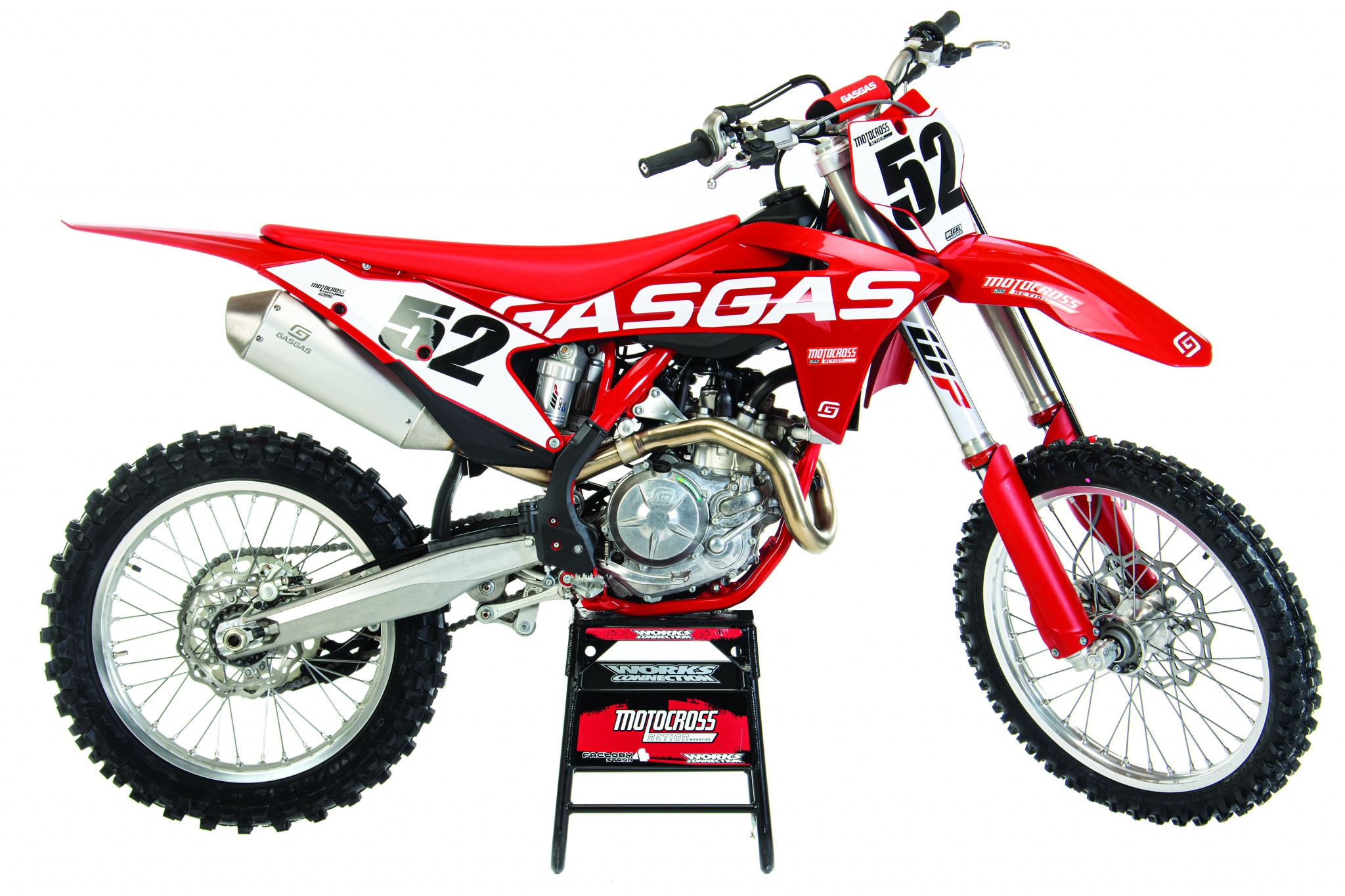 Compared to KTM forks, GasGas’ WP units are softer for a more comfortable ride. They feel like a blend of off-road and motocross forks—perfect for riders who think forks have gotten too pro-oriented.
Compared to KTM forks, GasGas’ WP units are softer for a more comfortable ride. They feel like a blend of off-road and motocross forks—perfect for riders who think forks have gotten too pro-oriented.
Q: HOW DOES THE 2021 GASGAS MC 450F HANDLE?
A: A reasonable percentage of MXA test riders felt that the addition of the forged triple clamps made the GasGas MC 450F corner better. The forged clamps are more forgiving and flexible than CNC-machined billet clamps. In 2019, the basic KTM, Husky and future GasGas chromoly frames were made 10-percent stiffer torsionally. The increase in torsional rigidity came from redesigned head-tube gusseting and a larger cross-brace. KTM’s goal was to reduce twisting from the front end during high-load cornering—and that is exactly what it did, which was great for Pros but universally disliked by Vets and Amateurs who preferred the softer and more flexible 2018 frame. The forged triple clamps feed back some of the flex that was taken out in 2019.
Initially, the test riders struggled with oversteer, which is unheard of on KTM and Husky frames. But, we slid the forks down in the triple clamps to the first line on the fork tubes; we slid the forks up in the triple clamps; we looked in the owners manual to get the correct torque specs; we put KTM billet triple clamps on the the MC 450F; we put very stiff aftermarket triple clamps on the GasGas; swapped to different front tires; we tried everything. The outcome was that most test riders felt more at home with the billet KTM clamps in place (which makes sense given that the chassis is a KTM 450SXF frame), but if money is an issue, we felt a big difference with the correct torque specs on the stock triple clamps.
With Austria’s third bike—the MC 450F—hitting new highs in overall handling prowess, chromoly has become the frame material of choice. It adds a degree of resilience that is not possible from a Delta-Box aluminum frame. Rigid frames put the onus on the bike’s suspension to provide absorption. A chromoly frame moves in harmony with its suspension.
Q: HOW DOES THE GASGAS MC 450F ENGINE RUN ON THE DYNO & TRACK?
A: The GasGas MC 450F holds its own on the dyno, making 57.37 horsepower and peaking at 9100 rpm. Torque is 36.51 pound-feet. As you would expect, it shares its dyno curve with KTM and Husqvarna in that all three have crescendo-style engines that build power steadily as they rev. Where they differ is in throttle response, with the KTM being the most responsive, the Husky second most and the GasGas third. Make no mistake about it, the GasGas does not feel as lively as the KTM 450SXF or as velvety smooth as the Husqvarna on the track. It feels weaker off the bottom and lacks punch in the midrange. You may find this strange, but we saw it coming. We never expected it to run as well as its Austrian stablemates. Why not? Three reasons.
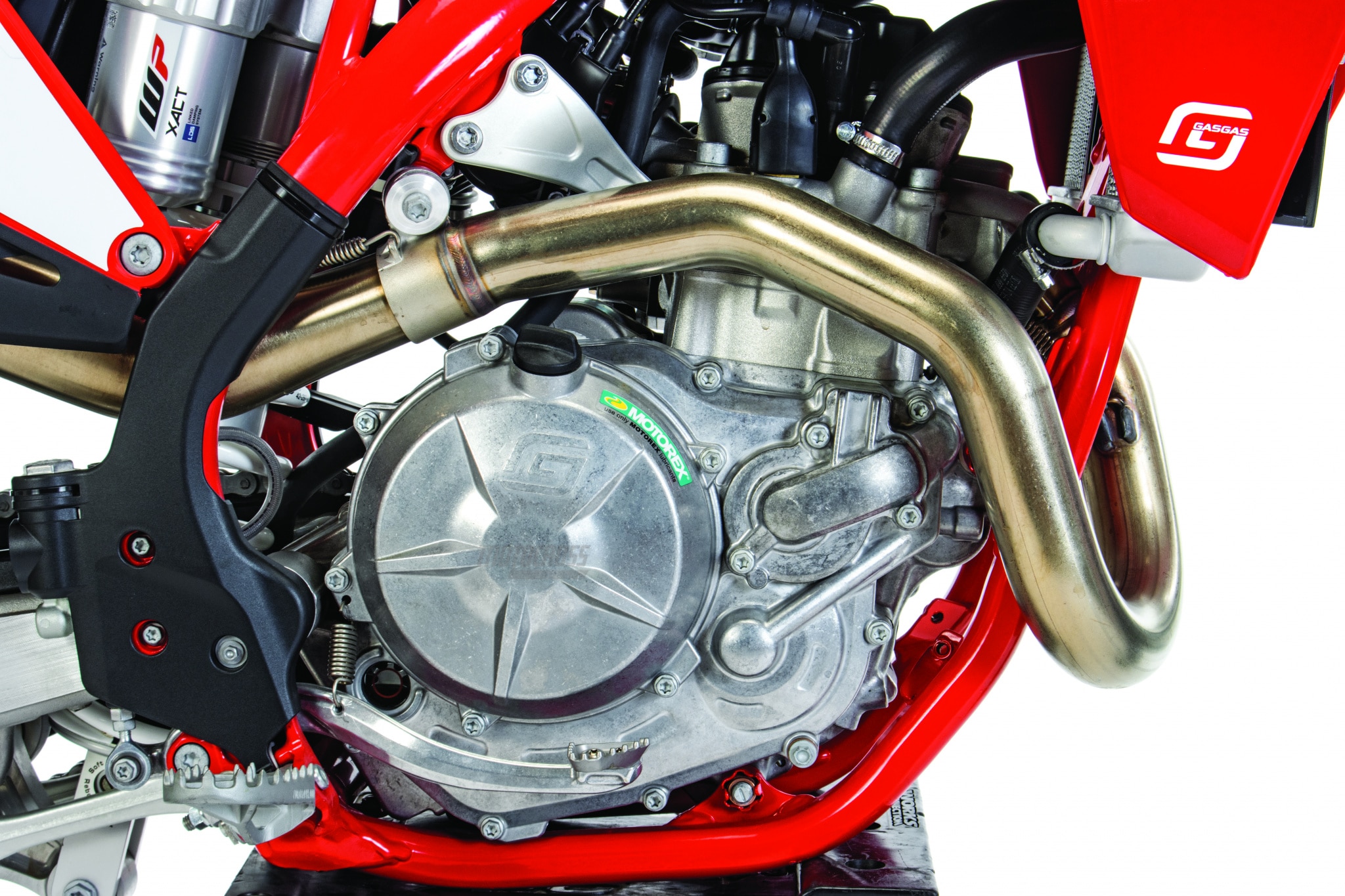
Q: WHAT ARE THE “WHY NOTS” OF THE GASGAS?
A: The GasGas MC 450F could easily run just like the KTM 450SXF if the GasGas engineers had wanted it to. We can only assume that they didn’t want it to. Perhaps they felt that a little less power would make the MC 450 a kinder, gentler motocrosser. We can buy that reasoning, but we can’t live with it. We did a little remedial R&D to bring the GasGas MC 450F up to snuff.
(1) Airbox cover. Unlike KTM and Husqvarna, GasGas does not make an optional vented airbox cover. Our first experiment with the GasGas airbox was to remove the restrictive GasGas cover and replace it with a vented KTM cover. The color was wrong and the fit wasn’t perfect, but every test rider came back raving about how much better the power felt off the bottom and through the middle once the engine could breathe.
When we put the GasGas airbox cover back on the MC 450F, we noticed that the winglet in the inside of the red airbox cover, which is designed to deflect dirt, also stopped any air from making it into the airbox. We compared it to KTM’s airbox cover, and KTM’s winglet on the vented cover was minuscule compared to the GasGas winglet. So, we cut it off and sent the MXA test riders back out again. The test riders felt that it made the MC 450F power much better—not as good as with the vented KTM airbox cover, but good for a free mod.
(2) Map switch. The GasGas doesn’t have the KTM multi-switch that lets you switch between two ECU maps, traction control and launch control; however, all of those features are embedded into the GasGas ECU—all you have to do is access them. Luckily, you can get the multi-switch from your friendly local KTM dealer. It retails for around $170 and plugs into a fitting behind the front number plate. Without the switch, the GasGas is always in KTM’s Map 1. We wanted the opportunity to switch maps, use traction control and have the option of launch control.
The trio of electronic aids are a plus to any rider who races at a variety of tracks or in all-weather situations. The ability to mate the maps with traction control gives the GasGas MC 450F the ability to drive out of corners when traction is plentiful while still modulating wheelspin when there is no traction.
(3) Muffler. You may not remember the 2013 KTM 450SXF, but it was the first of the Austrian bikes to be spec’ed with the “ice-cream-cone restrictor,” so-called because it looks like a rolled-up waffle ice-cream cone made out of perf core inside the muffler. The ice-cream cone made the 2013 KTM 450SXF quieter, but it also killed throttle response. In 2014, KTM dropped the one-year-old idea. We were very happy. Unfortunately, while KTM may have dropped the ice-cream cones, they reappeared on the 2014 Husqvarna FC450. The ice-cream cones were like a bad penny. They just kept resurfacing. Husky finally dropped the ice-cream-cone restrictors in 2021, but guess what? That’s right. The ice-cream cones have reappeared on the 2021 GasGas MC 450F. We have to wonder whose brother-in-law is making a mint selling ice-cream-cone-shaped restrictors to KTM, Husky and GasGas.
The restrictors aren’t necessary on a motocross bike, proven by the fact that when taken out, the KTM and Husqvarna mufflers still pass AMA and FIM sound tests. The only reason to put them in is to mute the power and throttle response, which isn’t a desirable effect on a motocross bike. We swapped our GasGas muffler for a KTM 450SXF muffler and could feel the difference. You can just add a slip-on muffler from your favorite exhaust supplier, but in our case we put a stock Husqvarna FC450 muffler on the GasGas MC450 (because we had one left over from pipe testing on the Husky).

Q: HOW MUCH CHEAPER IS THE GASGAS MC 450F?
A: The term “cheaper” is relative. The MC 450F costs exactly the same as a Kawasaki KX450 or Yamaha YZ450F, $200 less than a Honda CRF450, $800 less than a KTM 450SXF, $900 less than a Husky FC450 and $400 more than a Suzuki RM-Z450 (if the Suzuki dealer charged the MSRP). But, be forewarned; you can erase the savings quickly by making changes. Take that $800 you saved by buying the GasGas instead of the KTM 450SXF—just the map switch and FMF slip-on muffler will eat most of that.
Q: WHO IS THE POTENTIAL GASGAS MC 450F BUYER?
A: There are five types of buyers for the GasGas MC 450F:
(1) Better-red-than-dead die-hards. The all-new red 2021 GasGas is going to lure lots of buyers away from Honda. They have loyally bought red bikes, even from 2009 to 2020 when Honda wasn’t the hot option. They will likely stay with red by thinking about GasGas.
(2) Rebels. There have always been black sheep in the motocross world who want to be different. They know that with the limited availability of 2021 models, there won’t be many GasGas MC 450Fs on the track. That is a signal to let their freak flag fly on a GasGas.
(3) Orange-phobes. This is yet another opportunity for the orange-phobes to race a KTM without feeling like they sold out their anti-KTM beliefs.
(4) Long-term KTM owners. For riders who already own a KTM and have spent money on exhaust pipes, wheels, maps and suspension, they could get a brand-new GasGas for a reduced price and switch all their aftermarket parts over from orange to red. It would be cheaper than buying a new KTM.
(5) Money-conscious. With a KTM 450SXF going for $10,199, buying a $9399 GasGas MC 450F is almost a 10-percent discount, which makes ownership of the most advanced package in motocross a bargain of sorts.

Q: WHAT DID WE HATE?
A: The hate list:
(1) Mapping. The maps are there, but you can’t get to them without spending extra money.
(2) Vented airbox. There isn’t one available for the Austrian bike that needs it most.
(3) Sprocket bolts. Watch them for as long as you own the bike.
(4) Spokes. Always check the spoke next to the rear rim lock. If it is loose, and five times out of 10 it will be, tighten all the spokes.
(5) Neutral. We love how well the Pankl gearbox shifts from gear to gear but hate how hard it is to get it into neutral when standing still.
(6) Bike stand. When the bike is sitting on a bike stand, the front wheel is on the ground. This is a hassle when checking the spokes or working on the front end. Buy a bike stand that has a block to raise the front of the bike,
(7) Front brake hose. Be very careful when hooking tie-downs onto your handlebars that they don’t crimp the L-bend tube coming out of the front brake’s master cylinder. Always use soft straps.
(8) 2021 MC 350F. There isn’t a GasGas MC 350F in the 2021 lineup. No surprise. When KTM bought Husqvarna in 2014, there wasn’t an FC350 in its first model year, either.
Q: WHAT DID WE LIKE?
A: The like list:
(1) Brembo hydraulic clutch. The strongest clutch on the track.
(2) Brembo brakes. Brembo’s brakes are so well-modulated that one-finger braking is a no-brainer.
(3) Weight. The 2021 GasGas MC 450F weighs 222 pounds. By comparison, the CRF450 weighs 233 pounds, the KX450 234 pounds, the YZ450F 238 pounds and the RM-Z450 241 pounds.
(4) Throttle cam. Your GasGas MC 450F comes with the stock, long-throw throttle cam installed. Put on the quick-turn black throttle cam that came with your bike.
(5) Air filter. We love how foolproof it is to put an air filter cage into the KTM, Husky or GasGas airbox.
(6) Linkage seals. We drop-tested a 2021 SKF-equipped linkage against last year’s linkage. They made the shock linkage much, much smoother.
(7) Maxxis tires. We felt that the Maxxis MaxxCross MX-ST rear tire worked very well. The front tire was more terrain specific and tended to float at some lean angle which resulted in a push, but again it depended on the dirt consistency. When we ran the Maxxis MX-ST on hard-packed terrain, the rear tire shed knobs with alarming regularity.
Q: WHAT DO WE REALLY THINK?
A: This isn’t a true-to-life entry-level motocross bike. It retails for the same or less than the Big Four Japanese brands. And while you may not get KTM’s map switch, free-flow muffler, hour meter or vented airbox cover, you are getting a Brembo hydraulic clutch, Pankl transmission, steel clutch basket, 260mm Brembo front brake rotor, braided-steel brake hoses, 222-pound weight, quick-turn and long-throw throttle cams, ODI lock-on grips, quick-release fuel lines, in-line fuel filters, an indestructible chain guide, chromoly steel frame and KTM’s industry-leading engine technology—none of which the Big Four offer. Would we race one? We do every weekend.
MXA’S 2021 GASGAS MC 450F SETUP SPECS
This is how we set up our 2021 GasGas MC 450F suspension for racing. We offer it as a guide to help you find your own sweet spot.
WP AER FORK SETTINGS
To get the most out of WP XACT air forks, the rider has to be smarter than his fork. You have to understand that the air spring, which does the same job as a coil spring, holds the fork up on compression and extends it back to its starting point on rebound. Once you find the optimum air pressure for your weight and speed (easily done with a zip-tie on the fork leg), all damping changes are done with the compression and rebound clickers. The 2021 WP XACT air forks have the potential to be great (although most MXA test riders feel that the 2021 Husqvarna forks, which are 10mm shorter, feel better). For hardcore racing, we recommend this fork setup for an average rider on the 2021 GasGas MC 450F (stock specs are in parentheses):
Spring rate: 155 psi (Pro), 152 psi (Intermediates), 145 psi (fast Novices), 140 psi (Vets and Novices).
Compression: 12 clicks out
Rebound: 15 clicks out (18 clicks out)
Fork-leg height: First line
Notes: We got our best feel when the rubber ring on the fork leg was within 1-1/2 inches of bottoming, but that isn’t as easy to do as it sounds for slow or light riders. We had to lower the air pressure to get more travel and then use the compression damping to fine-tune the travel. We slid the fork down in the triple clamps to change the bike’s head angle to lessen oversteer. We tightened the top triple clamps bolts to 20 N/mm and the bottom clamp bolts to 15N/mm for a more solid feel on corner entrance. We waited for our friends to swap out the stock triple clamps on their KTMs for aftermarket clamps, and then we put their discarded KTM clamps on our GasGas MC 450 for a noticeable improvement.
WP SHOCK SETTINGS
Most MXA test riders liked the overall feel of the WP rear shock. We were concerned about the light 42 N/mm shock and lighter valving, but the combination delivered a more responsive feel for riders under 185 pounds. We run the low-speed compression on 15 clicks out, the high-speed compression 1-1/4 turns out, the rebound on 10 clicks out with the sag at 105mm. For hardcore racing, we recommend this shock setup for the 2021 GasGas MC 450F (stock specs are in parentheses):
Spring rate: 42 N/mm
Race sag: 105mm
Hi-compression: 1-1/4 turns out (1-1/2 turns out)
Lo-compression: 15 clicks out
Rebound: 10 clicks out (15 clicks out)
Notes: We were rightfully impressed by the shock; however, we turned the high-speed compression damping in 1/4 turn to lessen G-outs and ran more rebound than the recommended setting. If you weigh more than 185 pounds or are fast, order a 45 N/mm shock spring.




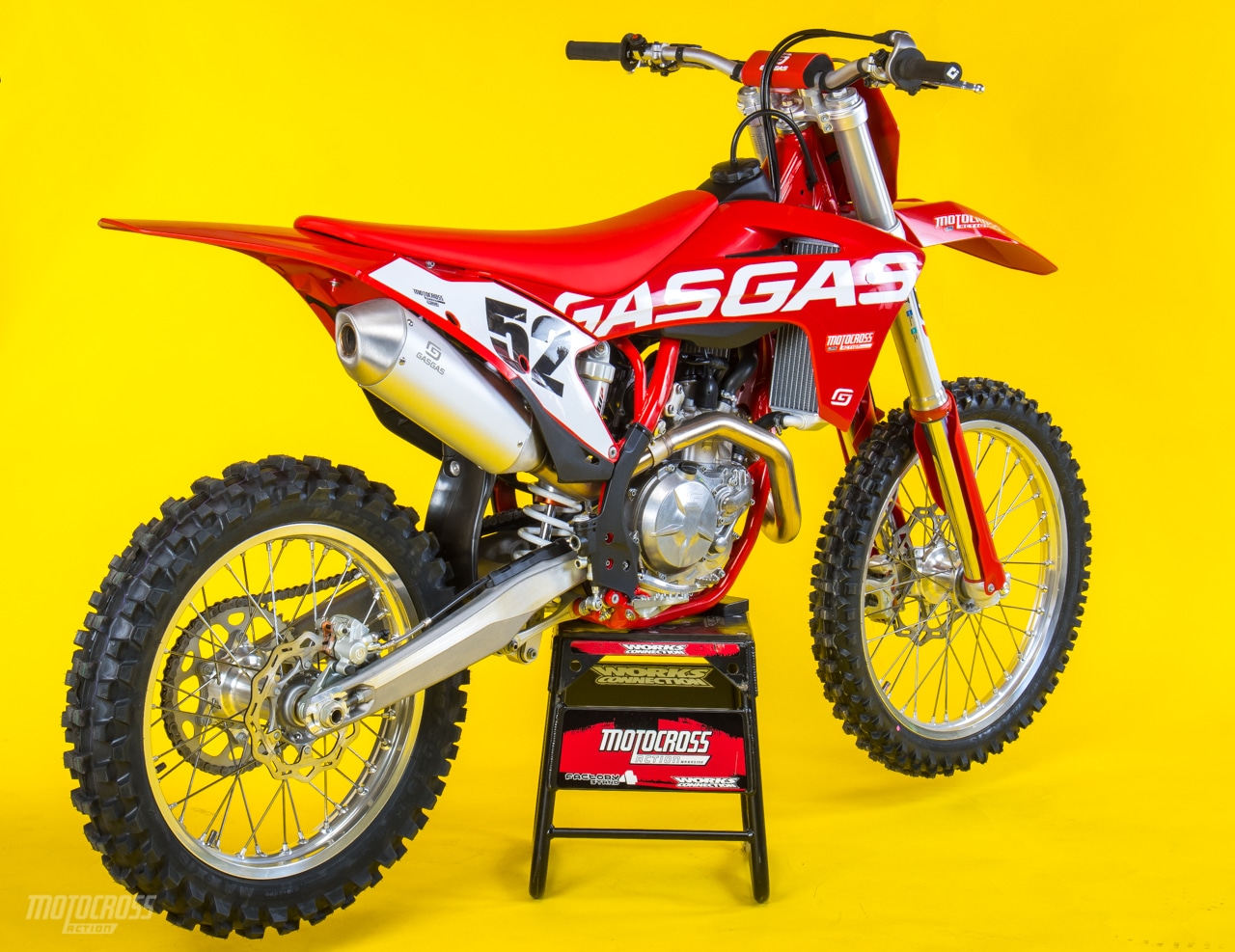
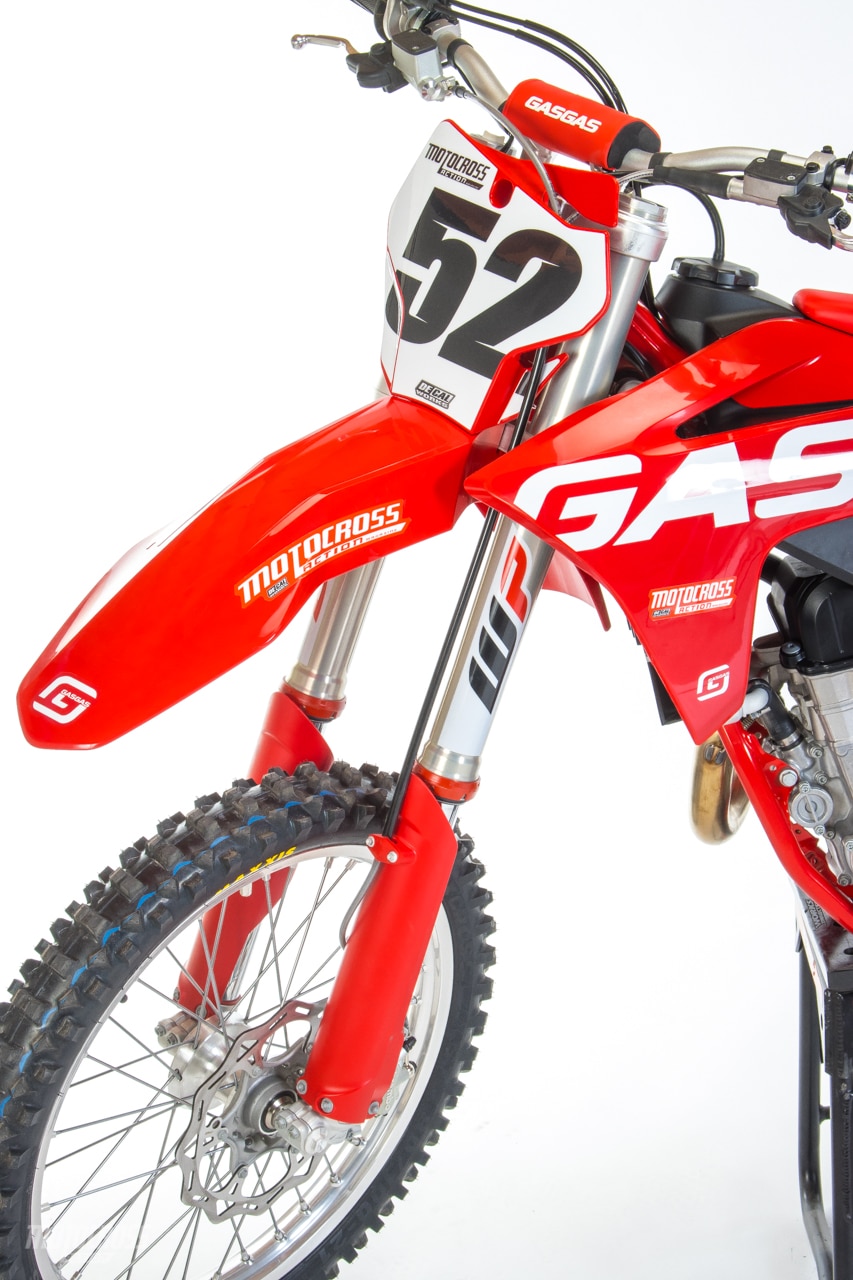





Comments are closed.